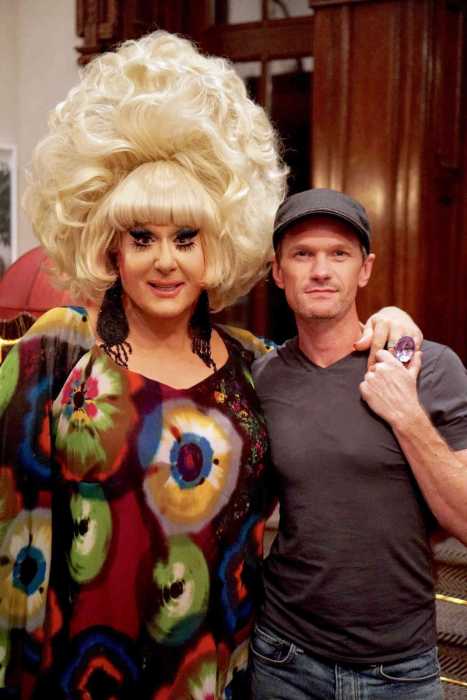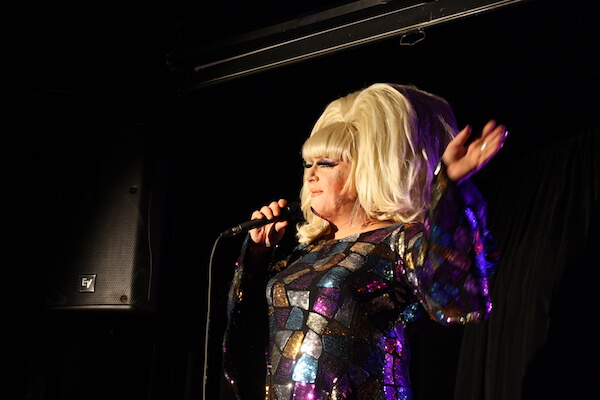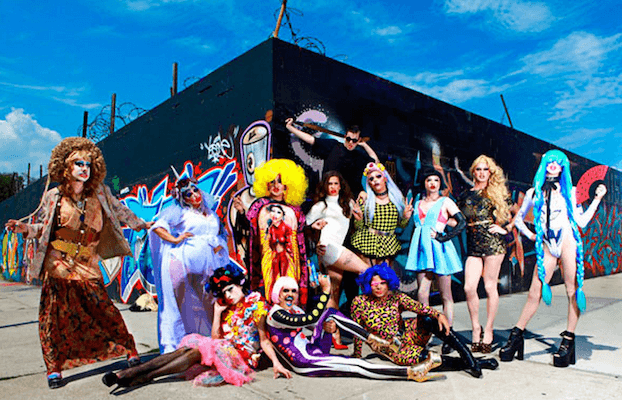“Freak Show” director Trudie Styler, star Ian Nelson, and David Noh, who moderated two Q&As with the director and actor at IFC Center this past weekend. | COURTESY: DAVID NOH
Trudie Styler, actress, producer, philanthropist, and the wife of rock god Sting, adds another accomplishment to her cornucopia of achievements, with “Freak Show,” her engaging, funny, and uplifting debut directorial feature film. Based on the novel by former notorious club kid James St. James — who once partied hard with the likes of Peter Gatien and convicted killer Michael Alig at the Limelight in Manhattan — it’s the tale of Billy Bloom (Alex Lawther), a gay, drag-obsessed teen who suffers daily bullying at the Southern high school to which he has been dragged by his rich, conservative father (Larry Pine), known as Daddy Downer. Bereft at being separated from his Auntie Mame-like mother (Bette Midler), he defiantly faces down the hatred by determining to be elected homecoming queen, and has the most unlikely of allies in Flip (Ian Nelson), the excruciatingly comely school football star, who is, himself, a closet artist.
To fall under the spell of Styler is a magical thing, indeed, and the moment she warmly embraced me recently in her gorgeous Central Park West digs, in front of a roaring open fire and a wall-sized Basquiat, I was handed a bowl-sized cup of cappuccino and whisked into the most vibrant, creative, and glamorous of worlds — her world.
The January 10 New York premiere of “Freak Show” (which has a leading anti-bullying non-profit, Stomp Out Bullying, as one of its sponsors), took place at the Landmark Sunshine Cinema — sadly on one of its very last nights being open — with a swanky party at Public Kitchen, and was attended by a glittering crowd, ranging from Hugh Jackman, Gina Gershon, and Donna Karan to downtown denizens like St. James himself, Lady Bunny, Amanda Lepore, Tony winner Lena Hall, and John Cameron Mitchell.
IN THE NOH: Trudie Styler talks about “Freak Show,” MoMA presents Joseph Cotten
Sting, greeting me with a double kiss, said, “My wife raved about you!” and introduced me to Gershon as “Dr. Noh,” which I hadn’t been called since fifth grade in Hawaii. Styler had earlier given me a hug at the theater, declaring, “I covet everything you have on!” Her birthday had just occurred, so it was a double celebration, as the crowd sang to her, and Hall and Mitchell, introduced as Sting’s “favorite cabaret artist,” performed selections from “Hedwig and the Angry Itch,” with Hall also doing a particularly knock-out job on Radiohead’s classic “Creep.” St. James also emceed a fashion show, featuring a Fellini-meets-Tim Burton cast of elaborately bedizened freaks.
My review of the film in Film Journal International moved Styler to ask me to moderate a couple of talk-backs with her and her star Nelson on the film’s opening weekend at the IFC Center. It was truly fun to hang in the theater’s raffish green room watching this diva arrive with her hair and makeup team and meeting the adorable Nelson, who’s from North Carolina, the youngest of four children of an opthamologist and has acted in the popular web series “Hey, Johnnie,” as well as playing Jennifer Lopez’s son in the agreeably trashy “The Boy Next Door,” which had that immortal line of dialogue uttered by its star, “I think he really likes me. He gave me ‘The Iliad’ for Christmas. It’s a first edition!”
Styler again admired my outfit and, saying that her Cartier Deco diamond arrow earrings matched it, removed one of them and bade me wear it for our Q&A. (The folllwing night, she regretfully said she’d had a pair of vintage Chanel earbobs for us to wear but had dropped one and broken it.) On both nights, the audiences were enthusiastic in support of this film, and their questions were answered with charming directness, humor, and, particularly in the case of Nelson, who actually boarded with Styler during the 22-day shoot, a particularly beautiful sincerity. Calling Styler his second Mom, he said, his days in New York were completely taken up with training sessions to prep him for his jock role, and drawing classes, museum visits, and artist encounters to explore the artistic side of his role.
Joseph Cotton and Jennifer Jones in William Dieterle’s “Portrait of Jennie,” with cinematography by Lee Garmes, screening January 25 at the Museum of Modern Art. | MUSEUM OF MODERN ART
During World War II, with many of Hollywood’s biggest matinee idols signing up for military duty, Joseph Cotten (1905-94), a newcomer from the Broadway stage, with credits to his name like “The Philadelphia Story” with Katharine Hepburn, became a star and probably the most interesting leading man on the screen of the day for the quality of films he was involved with and solid performances he delivered.
The Museum of Modern Art is paying tribute to him in its “Modern Matinee Series: Considering Joseph Cotten,” through February 28, and the chosen selections are certainly a nice way to escape the winter chill. Virginia-born Cotten’s career was inextricably linked with that of genius Orson Welles, whom he’d met in 1934, and he made his film debut in “Citizen Kane” (Feb. 16, 1:30 p.m.) as the title character’s humorous and sage BFF and sometimes nemesis. They followed that with the butchered masterpiece “The Magnificent Ambersons” — a much richer and deeper film than the loudly extolled “Kane” — in which Cotten gives one of the most ineffably charming and brilliantly understated performances in cinema as a pioneering auto magnate, thwarted in love and even somewhat skeptical of the impact his business will have on mankind.
Leading ladies particularly bloomed when cast with Cotten, with his quiet masculinity, obvious intelligence, and subtle yet nicely unsuppressed romantic ardor. These gift were nowhere more in evidence than in the haunting, richly satisfying Gothic romance/film noir, “Love Letters,” with its surprisingly terrific script by Ayn Rand, beautiful Victor Young score, magnificent Lee Garmes cinematography, and Jennifer Jones at her most radiant and compellingly neurotic as the amnesiac with a dark secret whom Cotten falls for.
Upcoming in the series are two more films he made with Jones, his courtly gravitas marvelously providing dramatic ballast for her rococo emotionalism, both produced by her husband David O. Selznick, for whom she was chief obsession, both personally and professionally. “Duel in the Sun” (Jan. 19, 1 p.m.) was the producer’s foolishly florid, high camp attempt to outdo the success of his “Gone with the Wind,” an epic Western in which Cotten is largely wasted in the pallid “Ashley Wilkes” role of pining for Jones, a gorgeous, uncontrollably lusty half-breed version of Scarlett O’Hara who prefers the dangerous “Clark Gable” character, as personified by a no-good Gregory Peck, with the telling name of Lewt McCanles.
“Portrait of Jennie” (Jan. 25, 1:30 p.m.) returned the pair to more familiarly ethereal terrain, with Jones cast as a girl who may actually be dead, but just doesn’t know who the hell she is, whether careening around in an exquisitely snowy Central Park or striking a very beauteous pose for artist Cotten in his shadowy studio in wondrously romantic and moody post-war Manhattan. All the Cotton-Jones films deserve to be watched on the big screen since they were photographed by the great Garmes, a virtual Rembrandt with light, who’d earlier turned Marlene Dietrich from plump hausfrau into total golden goddess in the exhilarating series of films he made with Josef von Sternberg in the 1930s.
Cotten doesn’t have all that much to do in George Cukor’s compelling gothic, lavishly produced “Gaslight” (Feb. 23, 1:30 p.m.), dominated as it is by Charles Boyer’s memorably malevolent tyrannical husband to Oscar-winning Ingrid Bergman’s sensitively rendered portrait of a Victorian bride in peril (with a pert, Cockney, 17-year-old Angela Lansbury already riveting as their sexy, uppity maid). Much less efficacious was Cotten and Bergman’s reteaming in Hitchcock’s “Under Capricorn” (Jan. 31 & Feb. 28, 1:30 p.m.), a Technicolor period thriller set in Australia, with definite similarities to “Gasight”’s confused wife formula, but a big old mess any way you look at it.
Carol Reed’s “The Third Man” (Jan. 26, 1:30 p.m.) is, next to “Ambersons,” Cotten’s finest film, a deserved classic of suspense with the darkest of overtones, set in a mesmerizingly eerie Vienna (which, when I visited it some years back, had a theater entirely devoted to daily showings of the film). Edard Albee’s “A Delicate Balance” (Feb. 14, 1:30 p.m.) was adapted into film in 1973 by Tony Richardson and, in it, Cotten plays one half of a mysteriously frightened-out–of-their wits couple who arrive at the posh home of close friends, aristocratic Paul Scofield and Katharine Hepburn, with the intention of never leaving again (one of Albee’s most brilliant and funny notions.)
More conventional leading man duty came with these: In the vividly Technicolored “Niagara” (Feb. 1 & 21, 1:30 p.m.), Cotten is cuckolded husband to Marilyn Monroe, as a ruthless vamp, early in her career, as opposed to the appealingly touchy-feely bimbo she later became. “The Farmer’s Daughter” (Jan. 24, 1:30 p.m.) has him putting up with Loretta Young in a cornball audience-pleaser that has her being Swedish ‘til it hurts, with a two-ton heavy accent and a blonde coronet braid. She mystifyingly won the 1948 Oscar for this — over the far more deserving Gene Tierney in “The Ghost and Mrs. Muir,” which, by the way, wasn’t even nominated. “I’ll Be Seeing You” (Jan. 18, 1:30 p.m.) was my father’s favorite song, and indeed the world’s, during World War II, and I imagine has something to do with the film, which is one of those “I’m a loser, so are you, let’s fall in love” soaperas positing Cotten, mentally shattered by the war, falling in love with shoplifter Ginger Rogers, just released from jail, who goes home with her deep dark secret to a much too inquisitive Shirley Temple, as her bratty sister.
For horror fans, there are two delectable entries: the indelible “Soylent Green” (Feb. 9, 1:30 p.m.), with its oft-repeated tag line that gives the whole show away and Edward G. Robinson, Charlton Heston, and Chuck Connors in a pissing contest as to who is the biggest ham. Along with this, MOMA is screening “Hush, Hush Sweet Charlotte” (Feb. 2 & 22, 1:30 p.m.), a true gay camp favorite, with Bette Davis at her most baroque-grotesque, essaying a Southern belle manque who faces eviction from her family plantation as well as the machinations of greedy Southerners like Cotten (calling up his own roots in a moustache-twirling way), Olivia de Havilland (surprisingly effective and mean in the role Joan Crawford bowed out of in the midst of shooting, claiming she was too sick to go on, yet sending press releases from the hospital), Agnes Moorehead (the very definition of hilariously over-the-top, as Bette’s maid, snarling Velma Cruther, whom this always enterprising actress seems to be playing as black but in white face), and Mary Astor, who quietly steals the entire film away in two mournful and melancholy scenes. The screening of this hysterical gem should be an especially lively one, given the affection an entire segment of the New York population (all of them gay) has for it.
FREAK SHOW | Directed by Trudie Styler | IFC Films | IFC Center, 323 Sixth Ave. at W. Third St. | ifccenter.com
MODERN MATINEES: CONSIDERING JOSEPH COTTEN | Museum of Modern Art, 11 W. 53rd St.| Through Feb. 28 |
$12; $10 for seniors; $8 for students at moma.org/calendar/film/3910?locale=en




































